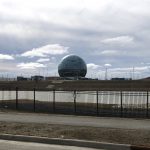DNR Working On New PFAS Rules
GOP controlled assembly rejects legislation enabling tougher regulation of "forever chemicals."
As concern continues to grow about PFAS contamination, the Wisconsin Department of Natural Resources announced plans Wednesday to institute rulemaking procedures to govern the family of ubiquitous chemical substances found in thousands of consumer, household and industrial products.
The action, authorized Wednesday by the independent National Resources Board (NRB) that oversees the DNR, comes one day after state lawmakers rejected attempts to enact legislation that would require the agency to undertake a program of tougher regulations on PFAS. But the DNR rulemaking would not replace that proposed legislation, the director of an environmental group says.
PFAS substances have been blamed for a growing number of chemical contamination incidents from Marinette to Madison, elsewhere in Wisconsin and across the country.
Gov. Tony Evers has focused on PFAS his first year in office when he declared 2019 the Year of Clean Drinking Water. He mentioned “getting PFAS out of our water” again in his State of the State address Wednesday evening, adding, “we’ve got work to do.”
“Today’s vote is a critical step to creating statewide protections against PFAS pollution,” said Carly Michiels, director of government relations for the environmental lobbying group Clean Wisconsin. “With residents all around the state already struggling with PFAS in their drinking water, we applaud the NRB for voting to allow this process to move forward.”
On Tuesday, the Republican majorities in both the state Assembly and the Senate rebuffed attempts to advance a languishing bill that would require the DNR to begin the process of developing regulations applying to PFAS. The bill, known as the CLEAR Act, is SB-302 in the Senate and AB-321 in the Assembly.
The Legislature instead passed SB-310, a more narrowly focused bill to tighten regulations for firefighting foam containing PFAS chemicals, which has now gone to Evers for his consideration.
Environmentalist: CLEAR Act still needed
In testimony before the NRB during its public hearing on the proposed rulemaking, Michiels of Clean Wisconsin said the DNR rulemaking now underway is not a substitute for the CLEAR Act.
“I do not think that this move takes any pressure off the CLEAR Act. This only bolsters the prioritization of PFAS as an issue in Wisconsin and the need for a more comprehensive approach and attention,” she stated at the time.
She noted that because of the length of the rulemaking process, it wouldn’t go to the legislature for review until 2022.
The CLEAR Act “addresses more PFAS compounds, more media including soils and air, and would do this under emergency rule,” giving it “a much shorter timeline.”
The bill also includes additional funding and resources for investigating PFAS contamination.
“This legislative approach can complement the rules that the DNR will be working on for PFAS in surface, drinking and groundwater, and we are still asking for the CLEAR Act to be given a public hearing,” Michiels said.
The PFAS problem
The potential hazard of PFAS, or perfluoroalkyl and polyfluoroalkyl substances, has drawn widespread concern in recent years. Related chemicals used in the production of the famous space-age product Teflon, essentially launching the non-stick cookware industry, were at the heart of the recent movie Dark Waters starring Mark Ruffalo as an Ohio lawyer who successfully pursued class-action litigation against Dupont, Teflon’s manufacturer.
Nicknamed “forever chemicals” because they have been found not to break down in the body, PFAS exposure has been blamed for reproductive and developmental effects and is suspected of being a hazard to the liver, kidneys, and the immune system. In humans PFAS substances have been associated with a wide range of health effects, from higher cholesterol levels and lower infant birth weights to immune-system effects, thyroid problems, and tumors and cancers.
DNR officials have identified the communities of Marinette and Peshtigo as the site of Wisconsin’s largest PFAS-contamination episode, and designated Johnson Controls International Inc. as the responsible party required to clean up the resulting pollution. The contamination has been traced to firefighting foam manufacturing and testing at facilities in Marinette owned by Tyco Industries before its merger with JCI.
Other PFAS contamination sites have been found in Rhinelander, Madison and elsewhere in the state.
PFAS substances are not regulated by the federal Environmental Protection Agency, because they mostly predate the EPA’s founding, when a lot of chemicals already in use were exempted from regulation.
Lengthy rulemaking process
Wednesday’s 5-1 vote by the Natural Resources Board is the first step in the department’s process of permanent rulemaking, which will establish state environmental standards for PFOA and PFOS, two principal subcategories of PFAS.
Evers originally ordered the rulemaking process in August, but he needed the NRB’s approval before the agency could move forward in drawing up the regulations.
The rulemaking will revise three separate state standards: for safe drinking water, to reduce PFAS substances in drinking water supplies; for groundwater quality, to reduce PFAS contamination in groundwater — Wisconsin’s main source of drinking water; and for surface water quality, by establishing discharge limitations for designated PFAS substances.
The rulemaking process has a 30-month deadline that starts with the drafting of scope statements for proposed changes. The DNR said the PFAS rule scope statements were completed in the fall of 2019, and include information about the background for the rule changes, an explanation of the rulemaking process and information about public participation.
The DNR then held preliminary hearings to take public comments about the prospective rules in Madison, Green Bay and Eau Claire in November.
“Public participation is a critical component of agency rulemaking,” a DNR statement on Wednesday about the rulemaking process noted. “There are numerous opportunities to participate in the DNR rulemaking process, from participating on the technical advisory committee to testifying at meetings and hearings.”
More about the PFAS Problem
- State Nears Settlement with Johnson Controls/Tyco Over PFAS Spills - Danielle Kaeding - Dec 4th, 2025
- Senate Bill Promotes Soybean-Based Firefighting Foam to Replace PFAS - Danielle Kaeding - Dec 2nd, 2025
- Test Results Show High PFAS Levels in Wisconsin’s Landfill Runoff - Danielle Kaeding - Dec 2nd, 2025
- Wisconsin Communities Get $282 Million for Drinking Water Projects - Danielle Kaeding - Nov 19th, 2025
- Gov. Evers, DNR Announce $282 Million to Improve Drinking Water Quality for Wisconsinites in 74 Municipalities - Gov. Tony Evers - Nov 18th, 2025
- Cleanup of PFAS Could Cost Wisconsin Billions - Danielle Kaeding - Nov 13th, 2025
- Cleanup PFAS Without Penalizing Innocent Landowners - Wisconsin Manufacturers & Commerce - Nov 4th, 2025
- Wisconsin Lawmakers, DNR Clash Over PFAS Protections in GOP Bills - Danielle Kaeding - Oct 8th, 2025
- Wisconsin Moves to Bring PFAS Limits In Line with Contested Federal Standards - Danielle Kaeding - Oct 3rd, 2025
- DNR Names Companies Responsible for PFAS Contamination In Northern Wisconsin Community - Danielle Kaeding - Sep 30th, 2025
Read more about PFAS Problem here






















